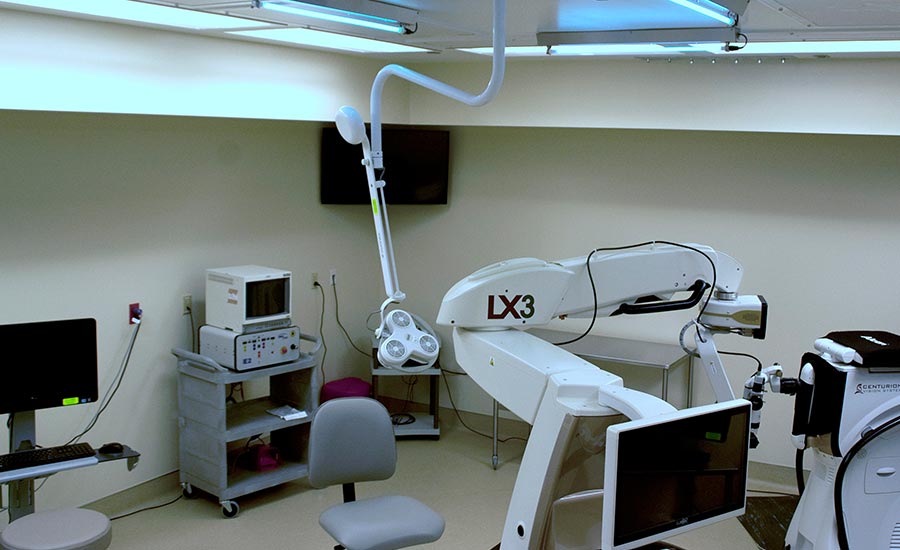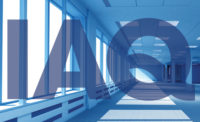St. Luke's Cataract & Laser Institute continues to pioneer the use of ultraviolet (UV) germicidal irradiation light systems for disinfecting surgery rooms and promoting clean HVAC system coils.
The Tarpon Springs, FL-based eye care company installed UV surface disinfection equipment to supplement daily manual sterilization in two operating rooms (ORs) in the Villages, FL, the newest of its seven central Florida clinics. Next, contractor Trinity UVC Lighting LLC will install UV lamps in three rooftop HVAC systems to supply the 9,600-sq-ft building with clean IAQ devoid of allergens, mold, and any other contaminants.
"As far as I know, we're one of the few, if not the only, eye care surgery company in Florida using UV disinfection to this degree," said Donald Bislick, facilities management and IT at St. Luke's.
St. Luke's other two OR locations, its headquarters in Tarpon Springs, and a 14,525-sq-ft clinic in Clearwater also have UV surface disinfection for ORs and HVAC coil disinfection. In an age when the Center for Disease Control (CDC) lists hospital acquired infections (HAI) as a major challenge for the healthcare industry, St. Luke's disinfection record is confirmed by external, independent reviews of the Accreditation Association of Ambulatory Health Care (AAAHC).
St. Luke's uses UV disinfection equipment providing UV-C wavelengths, which are most effective in eliminating microorganisms from OR surfaces and HVAC coils. UV-C light kills microbes by scrambling their DNA and preventing reproduction.
Trinity UVC Lighting specifies and installs 390-microwatt (µW) lamp systems manufactured by Fresh-Aire UV. The manufacturer claims the lamps are three times more powerful and require only three hours of nightly disinfection versus the health care industry's standard 120-µW lamps requiring eight to 10 hours of operation. Thus, the shorter, but equally effective disinfection time extends lamp life and saves energy.
UV surface disinfection system size and time exposure must be precisely calculated to assure total biological deactivation. Brian Stacy, Trinity UVC Lighting’s vice president of sales, references published data from organizations such as the CDC to calculate the micro-wattage required to irradiate any known biological contaminant. A calculation typically includes a room's square feet, ceiling to floor distance, lamp output, and a microorganism's recommended micro-wattage irradiation requirement to arrive at an effective exposure time. Additional variables include room ventilation air changes, humidity, lamp placement shadowing, and the space's allowable down-time for disinfection.
Stacy's calculations allow for the worst case scenario and also specify a 200% protocol above recommendations because all UV lamps slowly lose UV intensity over their expected one-year lifecycle. He also slightly oversizes a system to ensure even the most resilient microorganisms are irradiated.
"A static system such as this ensures the same disinfection time every day, whereas portable UV robots require qualified employees to program, position, and monitor them properly during use for efficacy," Stacy said.
The Villages clinic's 900- and 1,200-sq-ft eye surgery rooms each have four 32-in long, stainless steel ceiling-mounted, ozone-free UV lamp fixtures positioned in the middle of the rooms. Timers activate the lamps for off-hours disinfection. Since UV-C wavelengths can be harmful to eyes and skin, Trinity UVC Lighting has built in UV-monitoring entry-door interlock sensors and motion-detection safety measures that can prevent accidental activation during occupancy times. Systems also allow manual operation by authorized personnel with timed shut-offs after proper disinfection time.
After the warranty period, the service contract calls for Trinity UVC Lighting to periodically inspect all UV systems and perform lamp efficacy evaluation with radiometer instruments.
Trinity UVC Lighting will soon install eight 32-in and 46-in UV-C lamps in the Villages location's three York air handlers. The air handlers in the Surgery Center total 7,100 cfm and are supplied chilled water from The Villages' community central plant. Trinity UVC Lighting designs, custom-builds, and installs UV systems using Fresh-Aire UV power supplies, lamps, and other components engineered specifically for disinfecting an HVAC system's airstream, evaporator coil, and interior surfaces. The air handlers discharge air between 42°F to 47°F and in-duct electric re-heaters manufactured by Tutco Heating Solutions Group raise the temperature to surgery room temperatures as per ASHRAE Standard 170, “Ventilation of Health Care Facilities.”
St. Luke's Tarpon Springs facility is a three-story, 78,000-sq-ft facility and uses 40 UV lamps to disinfect both the supply and return side of eight air handler coils supplied by one 120-ton chiller manufactured by Trane and 80-ton and 40-ton chillers manufactured by Carrier.
Before UV lamps were installed, the Tarpon Springs facility needed semi-annual HVAC service calls to remove mold and slime build-up. Now the UV lamps prevent biological contaminant growth inside the HVAC systems and ductwork, thus saving the facility approximately $8,000 a year it once paid for coil maintenance. Aside from better patient/employee health, the clean coils also result in better heat transfer and energy efficiency. Furthermore, St. Luke's no longer uses toxic cleaning chemicals with gaseous contaminants that can damage the environment or prematurely corrode the coils.
The Tarpon Springs location's initial 60-day UV system trial in one HVAC unit produced impressive results and prompted the company to approve UV systems for the building's other seven HVAC systems. ES



